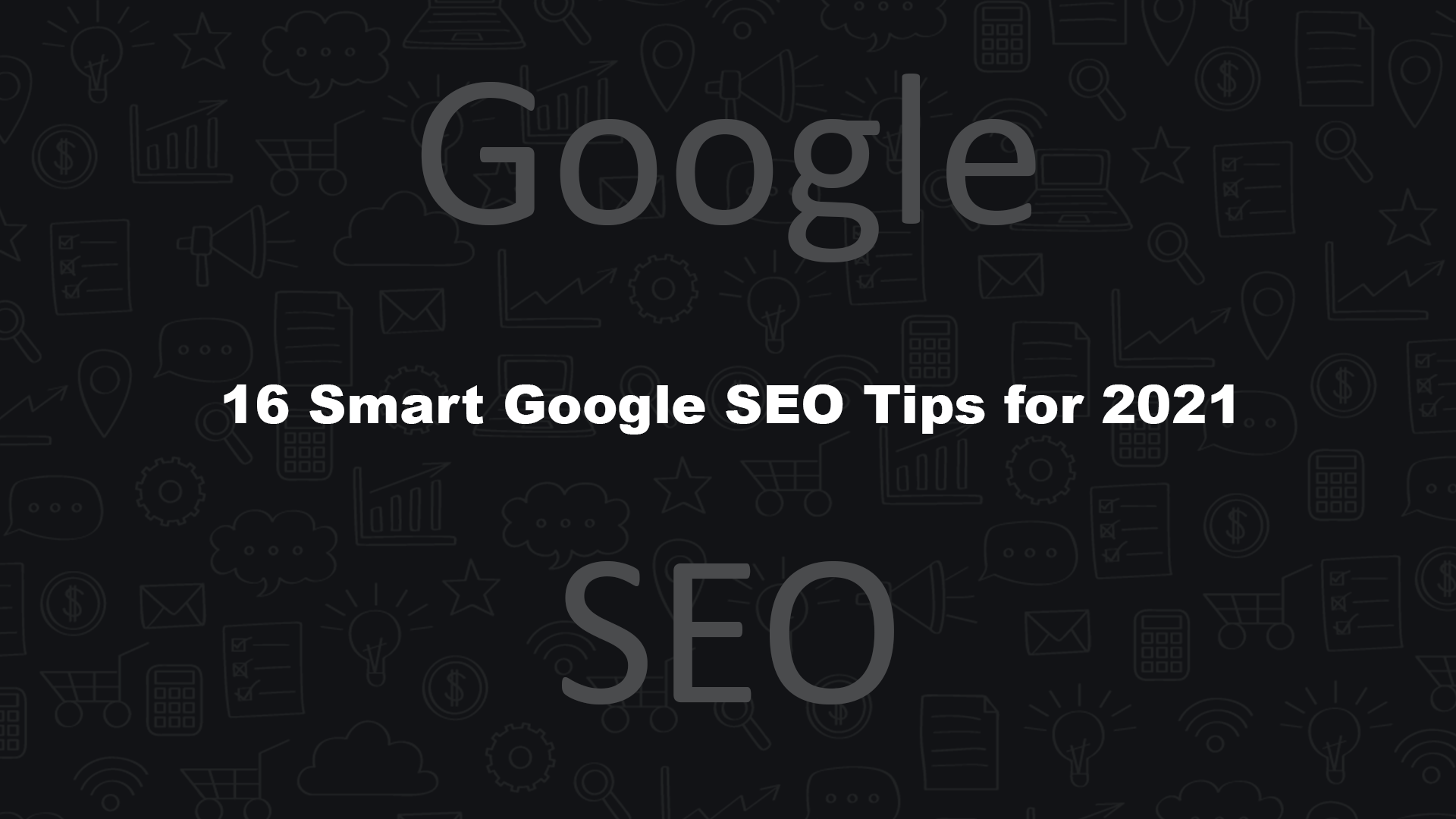16 Smart Google SEO Tips for 2021

SEO is a major part of marketing that helps in increasing the site’s visibility for relevant searches. Assume your site doesn’t show up on the front page of the Search Engine Result Page, you are not doing something correctly. And this blog has a solution to your problems.
If you want to make your website the benchmark for search engines & users, have a look at our top #16 SEO tips, which can be helpful for your website to rank at #1
Increase clicks
Let’s begin with clicks, especially earning more clicks from Google without really ranking higher because that’s one of the big things about SEO. You don’t really have to rank higher to get more traffic if you can earn more clicks from the rankings that you now have. So let’s consider some specific strategies for generating more clicks without increasing rankings.

1. Favicon optimization
First of all, favicon optimization.
Now I’m amazed more people didn’t talk about this in 2020. Google promotes favicons in mobile search results, and they can affect your click-through rate if they are high contrast, if they’re visible or not visible. Having a favicon can make a several percentage points difference, very little, but it does produce a difference if you can get it correct.
2. Breadcrumb optimization
While we’re optimizing our favicon, let’s take a look at breadcrumb optimization. Google promotes breadcrumbs in both mobile and desktop search results. They can be keyword-rich breadcrumbs, which can impact your click-through rate. Now Google gets their breadcrumb from a lot of places. That can be your website URL, your schema markup, and your real breadcrumbs on the page.
You want to make sure Google displays the breadcrumbs that you want them to show, using those keywords that you choose. The most secure way to do that is to make sure that you have breadcrumbs really on your page with links and that you’re doing schema markup. Ideally, it would suit your URL structure, but that isn’t always needed. So an excellent breadcrumb optimization audits.
3. Meta descriptions
Let’s optimize the Meta descriptions. This is so old-school SEO. But a new study shows that 30% of websites don’t even use Meta descriptions. That’s normal because another research shows that 70% of the time, Google will rewrite the Meta description, generally because it’s not utilizing the keywords that the user is searching. But if we write a strong meta description, it can force users to click, and that means using keyword-rich descriptions that people are searching for, so when Google does use your meta description, it’s promoting those clicks and acting as marketing copy for your website
4. Numbers in titles
Along with meta descriptions, titles. I just shared a study recently showing that dates added to titles improved rankings for a particular brand. Numbers are usually one thing that I always test in title tags that normally produce large consistent results. Especially, dates in title tag is usually a winner, January 2021.
Don’t be spammy about it. Don’t insert it if it doesn’t make sense, and don’t fake it. But if you can add a number, it will often increase your click-through rate for any given query.
5. FAQ and how-to schema
Tip number 5: schema, especially FAQ and how-to schema. Google provided us with a huge gift when they started these in search result. FAQ schema provides you lot of SERP real estate. You can’t forever win it, and you can’t ever win the how-to schema, but when you do, that can indeed influence people to click on your result, increase those FAQ schemas out.
It’s not suitable for every page. You need to make sure you have FAQs on your pages. Inappropriate situations it is one way that you can increase clicks without increasing your actual Google ranking. All right.
Content/on-page SEO
Let’s jump to some on-page and content tips.

6. Relaunch top content
All right, tip number six. In this year, we look into relaunching our top content.
Content can perform stale after a few years. So we launch content. We have a blog, we launch it, and we share it on social media. People forget about it after that. So go back, study at your top content over the last two to six years or even 10 years, if you need to go back that far, and understand what you can relaunch by updating it, putting it on the related URL. You can see increases of 500% to 1,000% simply by relaunching some of your old content with some updates in some cases.
So do a relaunch audit in 2021.
7. Increase internal linking
Number seven: improving internal linking. Many top SEO companies need to increase rankings for clients instantly, and there are usually two elements that they know are the easiest levers to pull. First, title tags and Meta description, what’s getting more clicks, but second is improving the internal linking.
You know that you can develop internal links on your site, and there are apparently some opportunities there that you just haven’t examined. So let’s talk about some of the simple ways to do that without having too much work.
8. Update old content with new links
Number eight is updating your old content with a new link. This is a step that we notice people jump time and time again. When you announce a new blog post, write a new piece of content, make sure you are going backward and updating your old content with those new links.
You’re looking at the best keyword that you want to rank for and going in Google Search or checking tools like Keyword Explorer to see what different pages on your site rank for that keyword and then add links to the new content to these pages. I notice when I do this, time and time again, it reduces the bounce rate. So you’re not simply updating your old page with fresh content and new links and adding relevance. You’re attaching links to your latest content. So make sure, when you publish fresh content, you’re updating your old content with those new links.
9. Remove unnecessary links
Number 9, remove irrelevant links from your content. Now, this is a sort of PageRank sculpting. It is a nasty word in SEO, but really, it works to a specific extent. It’s not nofollow link page sculpting.
It is excluding irrelevant links. Do you actually require a link to your team page on each page of your website? Do you require a link to your contact form on each page of your website? In many cases, you don’t. Sometimes you do. But if you eliminate the unnecessary links, you can pass more link equity through the links that really count, and those links are a major Google ranking signal.
10. Invest in long-form content
Number 10: I need you to spend on long-form content. Now I am not telling that content length is a ranking part. It is not. Short-form content can rank quite well. I want you to spend on long-form content because consistently, time and time again when we study this, long-form content gets more links and shares.
It also usually leads to rank higher in Google search results. Nothing against short-form content. Like short-form content. But long-form content usually gives you more bang for your buck in terms of SEO ranking potential.
11. Leverage topic clusters
Number 11, leverage topic clusters. Don’t just launch one piece of content. Make sure you write about various pieces of content around the same topic and link those together. When you do that and link them effectively, you can increase engagement because people are reading the different articles.
You can add the correct contextual inner links. I have a good case study that I want to explain to you in the transcript below, where someone did this and produced terrific results. So look into topic clusters for 2021.
12. Bring content out of tabs.
Finally, bring your content out of tabs. If you have content that is in drop-downs or accordions or you have to click to show the content, study after study after research shows that content that’s taken out of tabs and taken into the main body, so people don’t have to click to view, usually works better than content that’s stored in tabs.
Now to be fair, I don’t think that Google discriminates content in tabs. They appear to be able to index and rank it just fine. But I believe people usually engage with content when it’s out of tabs, and maybe some of those signs help those pages to rank a little better.
Technical SEO
All right. Now only a few technical SEO tips. We’re going fast.

13. Core Web Vitals
Number 13: this is the year to spend in Core Web Vitals. These are some of the page experience signs that Google is taking to the forefront in 2021. It’s going to be an exact ranking part very soon. We’re talking about cumulative shift layout, a difficult word to say. Usually, we’re talking about site speed and delivering an excellent page experience. Some of those things are very technical, and Google has excellent tools, like Lighthouse, to help you understand them.
One point I like to share, if you are on WordPress, I highly suggest using Cloudflare, in particular their APO for WordPress. It’s an excellent way to speed up your WordPress website and help you score better for some of these Core Web Vitals. It’s very cheap, it’s easy to implement, and it’s a great way to speed up your WordPress website.
14. Limit sitemaps to 10,000
Sitemaps, you’re allowed to have 50,000 URL per sitemap. This is constantly a question in every SEO quiz. How many URL per sitemap are you allowed? Alternatively, if you have a big site and indexing issues, tip number 14, limit your sitemaps to 10,000 URLs. You don’t have to use every 50,000.
We have some proof that using smaller sitemaps, reducing those into a limited URL set, can improve your crawl ability of those. Its kind of like Google might prioritize these in some way. The data seems to confirm it. You also get a little bit more valid data out of Google Search Console. You can notice what’s being indexed and what’s not.
Link building
Let’s immediately talk about link building tips for 2021 because everybody loves link building.
No, I am kidding. Everybody hates link building. Link building is so difficult. There are some experts, and there are some great people in the industry who do love it, who are excellent at it. Personally, I’m not that good at link building, but I still am able to build a lot of links.

15. Passive link acquisition
One way that I’m able to make that is number 15: passive link acquisition. Passive link acquisition means generating content that passively receives links as people find it in the SERPs.
It indicates I don’t have to outreach to somebody. It means that when they discover it when reporters find it, when bloggers find it, they simply want to link to it. You do that by building the types of content that reporters and bloggers, and web creators are looking for. These are generally guides, data, and definitions, how-to, such as this video. When you produce that kind of content, it usually earns as many links as people find it. The Passive link building is one of the most sustainable methods to obtain links over time.
16. Be the last click
Tip number 16 for 2021, be the last click. What do I suggest by that? I mean to satisfy your users. Once you obtain the first click, you want to make that first click that people click, but you also need to be the last click. That indicates they found what they are looking for. User comfort is ranking signal number one. Your aim with all of this is to satisfy the user, to give them what they search for.
That’s the magic of SEO. They’re looking for something, and you’re giving it to them at the right moment they are looking for it. When you can be the last click, you are almost assured of rising in rankings and getting the traffic you deserve.
All right, those are 16 tips. That’s your roadmap for 2021. I hope you enjoyed it.
Thanks, everybody.
Darshit Vaghela is a digital marketing executive, designer and blogger. He has associated with the Digital Agency called baya digital. He writes for many websites on various topics. He loves to read, write and travel.
